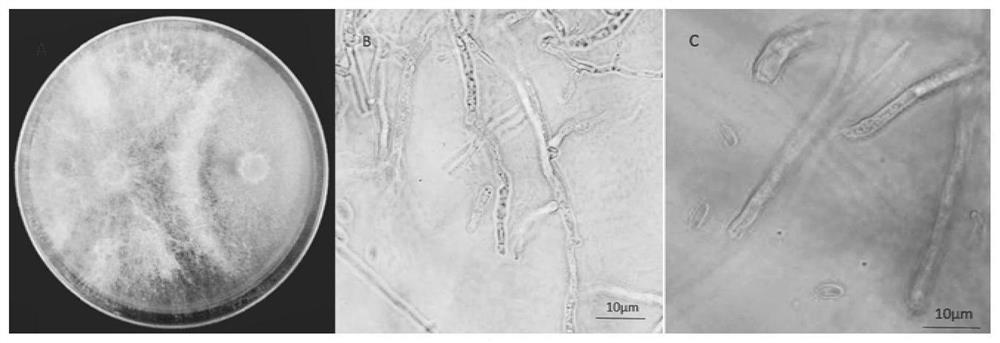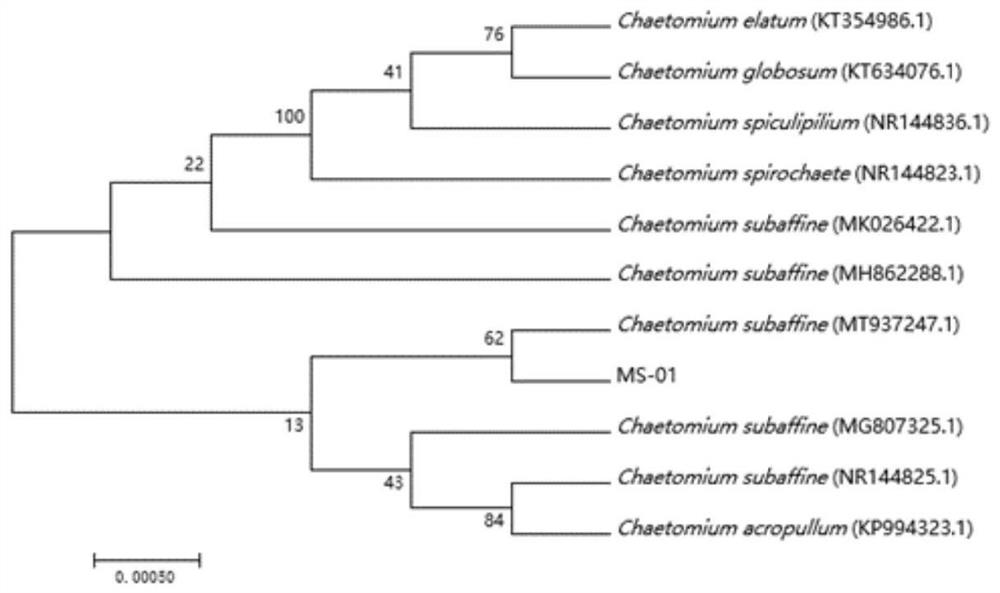Chaetomium subaffine, application and screening method
A screening method and technology for Chaetomium, which is applied in the field of Chaetomium close relatives, application and screening, and can solve the problems of soil microbial community destruction and unclear inhibitory effect.
- Summary
- Abstract
- Description
- Claims
- Application Information
AI Technical Summary
Problems solved by technology
Method used
Image
Examples
Embodiment 1
[0048] This example provides a method for isolating and purifying endophytic bacteria from ginseng roots by using the tissue separation method, which specifically includes washing the collected fresh ginseng roots with water first, removing the soil from the roots, washing them twice with sterile water, and then washing them with 75% ethanol Disinfect for 1 min, disinfect with 0.1% mercuric chloride for 30 s, rinse with sterile water 3 times, then use sterilized filter paper to absorb the remaining water on the root surface, and dry in the greenhouse for later use. Cut the tissue to be separated into thin slices of 0.5mm×0.5mm with a sterile scalpel, place it on a PDA plate, and culture it in an incubator at 25°C for 6 days. Four strains of fungi were obtained, respectively named as strains 1 to 4, and respectively named as MS-01 to MS-04.
Embodiment 2
[0050] This example provides a method for screening ginseng endophytes with biocontrol capabilities by using the confrontation culture method, which specifically includes picking endophyte bacteria cakes with a diameter of 5 mm from the edge of the colonies of the 4 strains of endophytes obtained in Example 1 and inserting them On the left side of the PDA plate, insert a Fusarium solani bacteria cake of the same size at the relative position of the same diameter on the right side of the PDA plate, set only the petri dish inoculated with Fusarium solani as a control, each treatment is repeated three times, and then Cultured at 25°C for 7 days, observed the growth of the colonies, and after 7 days, measured the colony radius (Rc) and the tendency radius (Rp) of only inoculated Fusarium solani fungus by the cross method, and calculated the antibacterial rate, calculated The formula is: antibacterial rate = (Rc - Rp) / Rc × 100%.
[0051] The bacteriostatic rate of 4 strains of en...
Embodiment 3
[0057] This example provides the No. 1 strain screened in Example 2 for the evaluation of antibacterial properties, specifically including activating the No. 1 strain screened on a PDA plate, and inserting the strain into PDB medium after culturing for 7 days, at 25°C, 120r·min -1 Vibrating culture for 7 days, the cultured bacterial liquid was filtered through double-layer sterile gauze to remove mycelia, and the obtained fermentation liquid was divided into two parts, one part was sterilized with an autoclave, and the other part was not treated in any way. Mix the above sterilized and non-sterilized strain No. 1 fermentation broth with the PDA medium cooled to 45°C at a volume ratio of 1:4 to make a solid plate containing the fermentation broth of biocontrol bacteria. As a control, the Fusarium solani bacteria cake with a diameter of 5mm was inoculated in the center of the plate, cultured in an incubator at 25°C for 7 days, the growth diameter of the strain was recorded, and ...
PUM
 Login to View More
Login to View More Abstract
Description
Claims
Application Information
 Login to View More
Login to View More - R&D
- Intellectual Property
- Life Sciences
- Materials
- Tech Scout
- Unparalleled Data Quality
- Higher Quality Content
- 60% Fewer Hallucinations
Browse by: Latest US Patents, China's latest patents, Technical Efficacy Thesaurus, Application Domain, Technology Topic, Popular Technical Reports.
© 2025 PatSnap. All rights reserved.Legal|Privacy policy|Modern Slavery Act Transparency Statement|Sitemap|About US| Contact US: help@patsnap.com



